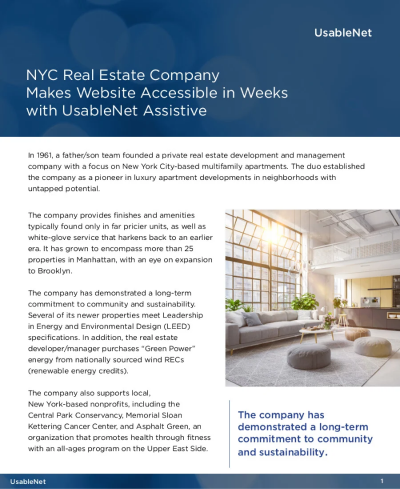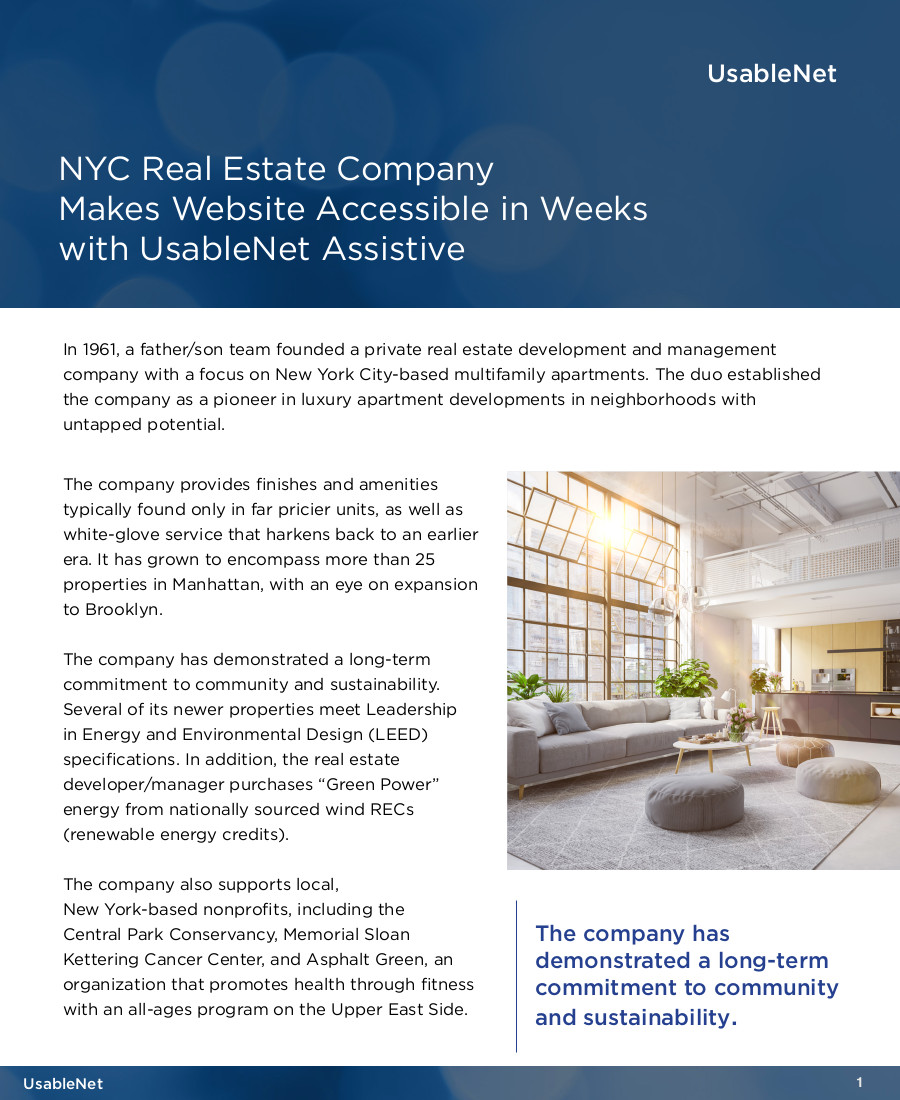Download a PDF version of this case study by filling out this form, or keep scrolling to read.

Test the accessibility of your website for free! Try UsableNet AQA. Test now!
In 1961, a father/son team founded a private real estate development and management company with a focus on New York City-based multifamily apartments. The duo established the company as a pioneer in luxury apartment developments in neighborhoods with untapped potential.
The company provides finishes and amenities typically found only in far pricier units, as well as white-glove service that harkens back to an earlier era. It has grown to encompass more than 25 properties in Manhattan, with an eye on expansion to Brooklyn.
The company has demonstrated a long-term commitment to community and sustainability. Several of its newer properties meet Leadership in Energy and Environmental Design (LEED) specifications. In addition, the real estate developer/manager purchases “Green Power” energy from nationally sourced wind RECs (renewable energy credits).
The company also supports local, New York-based nonprofits, including the Central Park Conservancy, Memorial Sloan Kettering Cancer Center, and Asphalt Green, an organization that promotes health through fitness with an all-ages program on the Upper East Side.

Chapter
Over the last decade, accessibility in real estate has expanded from a focus on the physical property (ramps, door widths, bathroom handles, and so on) to include the digital world. The first stop for most potential luxury renters is often a venue’s website, so any impediment to full access reflects poorly on the property, as well as its owners and managers. New York state occupies a particularly prominent place in this landscape—plaintiffs filed more web accessibility lawsuits there in 2018 than in any other state.
Likewise, the focus of legal action against these companies has moved online, with plaintiffs targeting a property’s digital assets in the hopes of bringing about a more accessible experience. In 2018, 3 percent of all ADA web accessibility lawsuits targeted the real estate and property industry. That number may seem low, but it reflects a growing trend that has captured the attention of owners and managers as they integrate digital assets into their accessibility efforts.
The Manhattan-based real estate developer/manager had already made significant improvements to its properties in compliance with ADA standards and quickly realized it needed to do the same for its website. The company brought on UsableNet to guide it through this process.
This would be no small task. The company’s site was complex with a lot of moving parts. It required a robust solution to meet ADA and WCAG guidelines without compromising the site’s content and functionality. The main challenge was blending two different sources of content and making them both accessible:
The real estate developer/manager’s goal was simple—improve its site’s accessibility to the point where it would receive a score of “zero critical errors” from tools that crawl and rate sites while maintaining its extensive array of features.
Chapter 2
A nagging question loomed over the real estate developer/manager’s accessibility process—how do we maintain and continually update our website for daily business and still provide accessibility at all levels to those who need it?
UsableNet Assistive’s cloud-based approach dynamically made the site accessible in a few weeks. UsableNet did all the work to make the site accessible and maintain it. The real estate developer/manager only had to put up an “Enable Accessibility” link on the site. This solution has allowed the company to freely update or change site content without having to change its process or do any accessibility-related coding.
Chapter 3
The real estate developer/manager now proudly boasts an accessible site with zero critical errors.
Its team can continue to manage and update the site, confident that accessibility will remain intact because of Assistive’s managed service, which provides ongoing automated testing, manual testing, and remediation. This has given the company confidence that its site is accessible to people of all abilities and helps the company mitigate legal risks.
Digital accessibility is now a core part of the real estate developer/manager’s outreach strategy, alongside its daily physical operations. UsableNet is an essential partner in this process, providing the technology and people that keep the website inclusive and open to all.
Chapter 4
The real estate developer/manager has made an ongoing commitment to accessibility, as both a moral and business imperative.
True to the pioneering spirit of its founders, the company welcomes people of all abilities to its website, as it has done with its properties for nearly 60 years.
UsableNet will continue to monitor the ADA and WCAG standards for the company. The Assistive managed service ensures that someone will always have a watchful eye on the site and accessibility will remain current and top of mind with updates performed as needed. Assistive is cloud based and works with third-party vendors when accessibility is needed with different kinds of functionality on the site.
Most crucially, UsableNet monitors the state of ADA laws, WCAG standards, and the current legal climate and then recommends and implements any necessary changes to keep the site compliant and accessible to all. This provides peace of mind and removes a significant worry from the real estate developer/manager’s daily operations.
UsableNet’s solution to the company’s problem was comprehensive, removed the heavy lifting, and didn’t add complexity to the real estate developer/manager’s existing technology, nor did it force the company to change its digital presence. Avoid expensive and time-consuming updates with a trusted industry leader. Get started today with a primer on Assistive. Or, if you’re ready to talk one on one, we’d love to hear from you.
Simply fill out this form to receive a PDF version of our case study.
